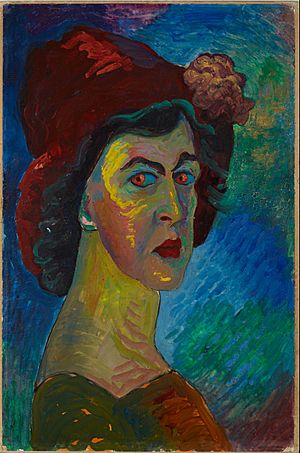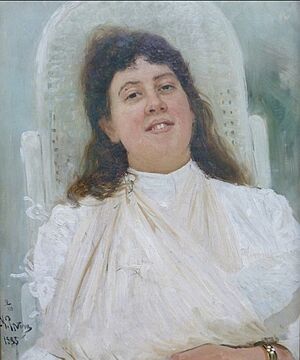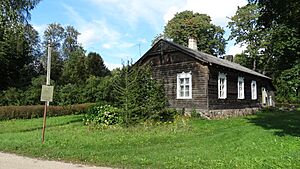Marianne von Werefkin facts for kids
Quick facts for kids
Marianne von Werefkin
|
|
|---|---|
| Марианна Верёвкина | |

Self-portrait, c. 1910
|
|
| Born |
Marianna Vladimirovna Veryovkina
10 September 1860 Tula, Russian Empire
|
| Died | 6 February 1938 (aged 77) Ascona, Switzerland
|
| Known for | painting |
| Movement | Expressionism |
Marianne von Werefkin (born Marianna Vladimirovna Veryovkina; 1860–1938) was an important Russian artist. Her paintings are a key part of Expressionism, an art style that started in Germany.
Contents
Life as an Artist
Early Life in Russia (1860–1896)

Marianne von Werefkin was born in Tula, Russia. Her father, Vladimir Nikolayevich Veryovkin, was a general in the Russian army. Her mother, Elizabeth Daragan, came from a family of Cossack princes.
Marianne's talent for drawing was noticed when she was just 14 years old. She quickly began taking drawing lessons. As a teenager, she had a large art studio in Saint Petersburg. She also had a studio at her family's summer home in Lithuania. This home was called "Blagodat," which means "Grace" or "Blessing."
In 1880, Marianne became a student of Ilya Repin. He was a very famous Russian painter known for his realistic art. Through Repin, Marianne met other artists and learned a lot. She also studied painting with Illarion Pryanishnikov.
In 1888, Marianne had an accident while hunting. She accidentally shot her right hand, which was her painting hand. This was a very difficult time for her.
Before 1890, Marianne was known as the "Russian Rembrandt" because of her realistic paintings. After 1890, she started to paint in a more modern style. She began painting outdoors, which was part of Impressionism.
In 1892, Marianne met Alexej von Jawlensky, who was also a painter. She was more experienced than he was. She decided to help him learn and grow as an artist.
Moving to Germany (1896–1914)
In 1896, Marianne's father passed away. She received a good pension from the Tsar. This allowed her to move to Munich, Germany, with Jawlensky. She also brought her young helper, Helene Nesnakomoff.
In Munich, Marianne rented a large apartment. She filled it with beautiful furniture. She decided to stop painting for ten years to focus on Jawlensky's art education. She believed it was important to support his artistic journey.
Marianne also started an art group called the Brotherhood of St. Luke in 1897. This group later helped create two important art movements: the New Artists' Association Munich (N.K.V.M.) and The Blue Rider.
In 1906, Marianne started painting again. She traveled to France and found new inspiration. She began to create her first Expressionist paintings in 1907. Her new style was influenced by artists like Vincent van Gogh and Paul Gauguin. Her friends in Munich even called her "The Frenchwoman."
In 1908, Marianne, Jawlensky, and other artists like Wassily Kandinsky and Gabriele Münter met in Murnau, Germany. They painted together and developed new ideas. Later that year, they officially founded the N.K.V.M.
Marianne showed her paintings in the first N.K.V.M. exhibition in 1909. She exhibited six paintings, including one that showed her interest in Bavarian folk art.
In 1911, Marianne and Jawlensky met Henri Matisse in Paris. In 1912, they left the N.K.V.M. and continued to exhibit their work with other modern artists.
Life in Switzerland (1914–1938)
When World War I started in 1914, Marianne and Jawlensky had to leave Germany quickly. They moved to Switzerland. Because of the war, Marianne's pension was cut.
After the Russian Revolution, Marianne lost her pension completely. This meant she no longer received money from Russia. She became a stateless person, which means she didn't have a country to call her own. She was given a special travel document called a Nansen passport.
In 1918, Marianne and Jawlensky moved to Ascona, Switzerland. She continued to exhibit her paintings. In 1921, Jawlensky moved away from Marianne.
During this difficult time, Marianne found new friends and continued to paint. In 1924, she helped start a new art group called Der Große Bär (The Great Bear). This group had many exhibitions.
Marianne often earned money by painting posters and postcards. She also wrote articles for newspapers. Her later paintings became more thoughtful and mysterious. They often showed Russian influences, even when she painted Swiss scenes.
Marianne von Werefkin died in Ascona, Switzerland, in 1938. She was buried there with many people attending her funeral. A large collection of her art and writings is kept in the Fondazione Marianne Werefkin in Ascona.
Honours
There is an art prize named after Marianne von Werefkin. It is called the "Marianne-Werefkin-Preis." This award is given to talented female artists every two years.
Gallery of paintings
See also
- List of Russian artists













